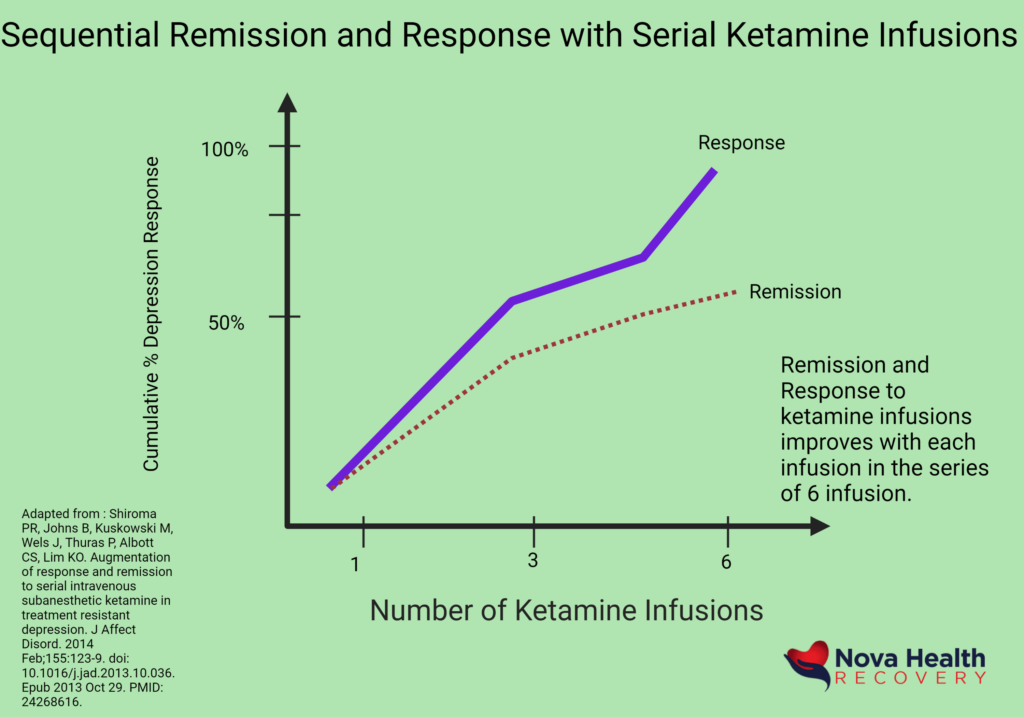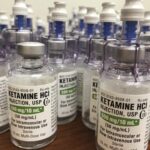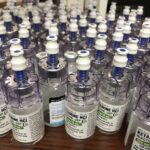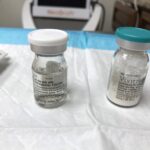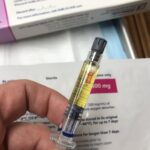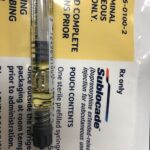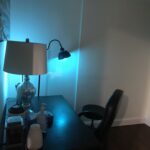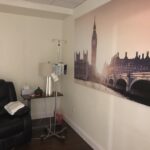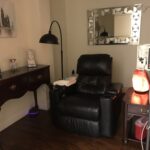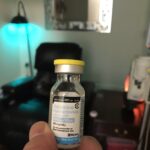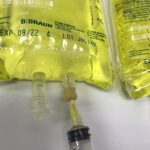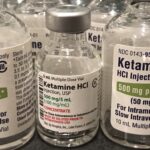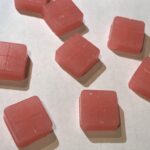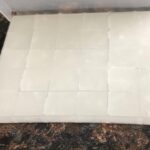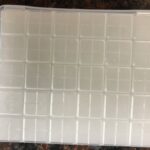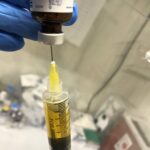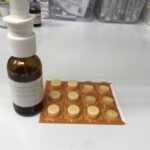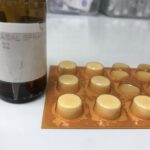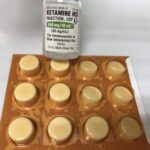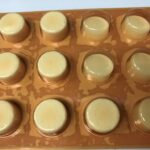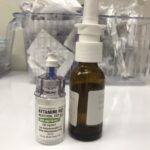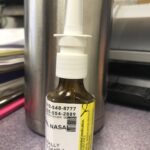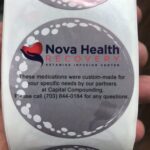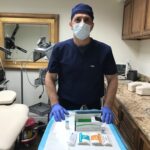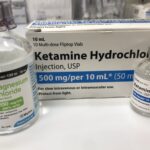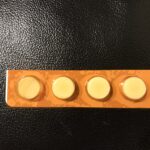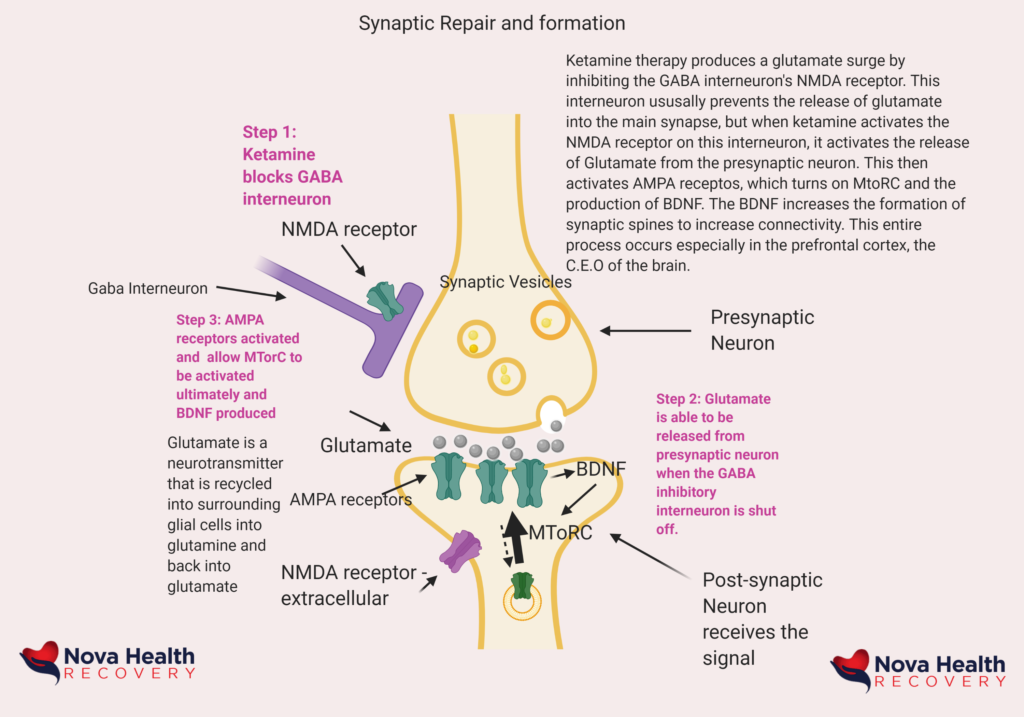-
Ketamine rapidly produces remission or significant improvement in treatment-resistant depression within days.
-
Up to 70% of patients may have remission or response even if they have failed ECT, TMS, and multiple medications.
-
Each therapeutic ketamine infusion costs $399. There is an initial mental health integration session/medical evaluation that costs $350. We will discuss your mental health journey, describe the ketamine treatment process, and discuss how to integrate the experience into your recovery. We do require a deposit to hold an appointment time. Once scheduled, we will send you intake paperwork. If you have any medical records available, those are helpful but not necessary to proceed with treatment.
-
The consultation can be done on the same day as the first infusion of ketamine.
Insurance does not cover this treatment, but we can provide superbills for you to submit for out-of-network costs unless it is Medicaid, Medicare, or Tricare. -
You can use care credit, which is a medical credit card to cover costs and offers 0% interest for 6 months. Other payments are by credit card, HSA card, or debit card.
-
For mood disorders, such as depression, you will need at least six treatments (occasionally up to 8 treatments) over two weeks.
-
Infusions are done Monday, Wednesday, and Friday from 9 A.M. – 9 P.M., with each session lasting one hour.
-
You will be able to work in between treatments. In fact, many patients come to the office after work for their treatment, as we are open until 9 P.M.
-
There is no cure for mental health disorders – only treatments. The goal is to provide remission, improved quality of life, and functionality. Relapse occurs with every available treatment.
Ketamine is a treatment, not a cure. With improvement or remission, booster infusions are recommended at 2 weeks after the initial series and then a month later.
-
You will need boosters once a month for a few months in general.
-
Anyone is a candidate for this treatment. Exclusions include pregnancy, schizophrenia, liver failure, and kidney failure. Some conditions may require medical clearance before treatment, such as heart attacks within the past year, angina, COPD (emphysema) , recent stroke, uncontrolled blood pressure, uncontrolled diabetes, and several other conditions.
-
The main side effect of ketamine therapy is nausea during the infusion, for which we use prophylaxis with medications. We will send in a prescription for anti-emetics to your pharmacy ahead of the treatment as well.
-
The other side effect of ketamine therapy is loss of coordination (dizziness) for an hour or two after the infusion that returns to normal rapidly. This is the reason you will need a ride home.
-
We can schedule you rapidly, sometimes on the same day, in order to start treatment. We can also do the integration and first infusion on the same day.
-
The therapeutic ketamine infusion is dosed at 0.5 mg/kg-0.75 mg/kg over 40 minutes for each session.
-
You cannot drive for four hours after an infusion. You will require a driver for Uber to go home.
-
No referral is required. If you do not have any significant medical conditions, you can receive this treatment.
-
Dr. Sendi will evaluate each case at the consultation to determine the appropriateness of treatment.
What Does Ketamine Treat?
- Depression
- Suicidal Thoughts
- Anxiety
- Pain
- CRPS
- OCD (Obsessive Compulsive Disorder)
- Fibromyalgia
- Cluster Headaches
- Chronic Fatigue Syndrome
- Neuropathic pain
- Migraine Headaches
- PTSD
- For Mindfulness, hypnosis, guided imagery
How is Ketamine Administered?
- Generally Intravenously over the course of 40-50 minutes. This gives an exact, effective dose that bypasses the liver and goes to the brain, where it is needed. This is a more effective way to initial treatment.
- Intranasal Ketamine : A home-based nasal spray is available for treatment of depression, anxiety, pain, and PTSD.
- Oral Ketamine At-Home Therapy as Troches, Ketamine Dots, and RDTs.
How does Ketamine work?
- Ketamine acts, in part, as an antagonist at the NMDA receptors, which are overly stimulated in depression. This results in increased neuroplasticity, in which dendrites on neurons can reform. This produces a brain ‘reset’ in which new connections can be made. Depression has been shown to be associated with a loss of synaptic connections in the brain.
- Ketamine causes the release of Brain-Derived Neurotrophic Factor (BDNF), which allows the process of neuroplasticity.
- This is an immediate effect of Ketamine infusions.
Do I need a referral?
- You do not need a referral for Ketamine Infusions. Certainly, background information on prior treatments is helpful.
Is there anything that excludes me from this treatment?
- Medical issues such as active liver disease, COPD, kidney failure, heart disease, and uncontrolled blood pressure are concerns that may require a more in-depth clearance.
What conditions is Ketamine Treatment useful for?
- Depression, PTSD, Anxiety, Bipolar, OCD, Pain, headaches, cluster headache, Lyme disease, Cancer pain, CRPS, and phantom limb pain can be effectively treated with Ketamine.
- We do utilize Ketamine for the treatment of cocaine, opiate, and alcohol use disorders.
What is the Appointment Availability for Infusions?
- Our Ketamine Treatment Center has immediate availability. We see patients for initial preparation-integration sessions Monday, Wednesday, and Fridays from 9 A.M.-9 P.M.
How Many Infusions will I Need?
- It is recommended that Ketamine Therapy for depression be utilized for a total of six (6) sessions and up to 8 initial infusions spaced 2 to 5 days apart or twice to three times a week
- Effects are noticed, on average, by the fourth infusions.
- Improvements are tracked with mood apps and medically validated scoring systems as well as through neurocognitive testing with Creyos testing.
How long does an infusion Last?
- CRPS and pain infusions can last 4 hours and span 3-5 days consecutively.
- For mood disorders such as depression, each infusion is about 40 minutes.
- You will need a driver to take you home (or an Uber)
- You will be able to work the next day after the infusion.You do not need to take any time off work to undergo this treatment.
What side effects occur with Ketamine infusions?
- Nausea and vomiting may occur in 10%. We pre-medicate with scopolamine patches, meclizine, Zofran, Phenergan, or compazine to prevent this.
- Dizziness may last several hours.
- General malaise and mild headaches may occur the next day
- Psycho-mimetic responses such as brief visual distortions or auditory hallucinations may occur during he infusion. This is the ‘trippy’ part of the therapy. Most patients find the experience pleasant.
Am I awake during the infusions?
- Generally yes. We recommend you bring headphones and ambient music without words to enhance the experience.
- Texting and phone calls are not recommended.
- You do not have to dissociate or lose control during an infusion to get antidepressant results. There is no need to have a ‘journey’ as results are due to neuroplasticity.
Can I drive after the infusions?
- No driving for 6 hours after an infusion. You will need a ride to and from the infusion.
Can I eat before coming in?
NOVA Health Recovery Ketamine Center recommends no food for two hours prior, but liquids are fine
How do I prepare for the infusion?
- Bring a headset and your own music, preferably ambient, soothing music.
- Try to frame the infusion in a positive context. If someone is going to accompany you, they may sit with you.
- If there are bothersome thoughts you wish to deal with, consider using the infusions as a way of therapy to package the thoughts into a better light.
-
- Clear your mind and declutter your schedule for the day.
- Set aside time to reflect on your journey after the infusion.
- Consider journaling before, during, and after the infusion all the experiences you have.
- Movement is important, so exercise earlier in the day or several hours after the infusion can be helpful in promoting better outcomes.
- Meditation the day of the infusion can place you more ‘in the moment’ and prepare you better.
- Avoid alcohol and Marijuana. Marijuana interferes with many medications as it activates specific liver enzymes that metabolize medications.
- Try to take the rest of the day off after the infusion. Clear your schedule.
What Will the Infusion Feel Like?
- As the infusion begins, you will feel numbness and heaviness in your face, arms, and legs.
- You may feel that you are floating or separating from your body at higher doses
- The first infusion is a lower, therapeutic dose to make you comfortable with the treatment. Doses escalate with each infusion but remain below anesthetic doses.
- The infusion experience ends within minutes of stopping the IV.
- If you feel anxious, try to redirect your mind to a safe thought. If you still feel uncomfortable, we can administer a mild sedative to help.
- Let your musical selection help guide your journey. If the music is, for some reason, unhelpful or distracting, it can be changed or turned off. If the music evokes bad memories, consider using that time to explore those feelings.
- Many people find it difficult to use words to describe their infusion experience. Whether the experience is awesome, neutral, or sad does not affect the results of neuroplasticity that results. The infusion experience is a side-effect of the infusion. The infusion does allow an opportunity to explore and reprocess your memories and emotions.
- You may notice sensory distortions during the infusion, such as immersive colors, enhanced sound perception, and even synesthesia. You may be able to feel the color red and taste ‘middle C’ as the ketamine allows deep sensory areas of the brain to connect and exchange information. There may be altered states of consciousness, empathy, connectedness, or a sense of oneness with the world. There can be contrasts such as ‘feeling as if you have died, yet never having felt more alive than at that moment.’
- Each journey is different and unpredictable.
- Recognize that the way a journey makes you feel is not associated with outcomes. Some of the infusion experiences are sad, fear-provoking, or disturbing. It is important to journal each infusion afterward. Understand new concepts brought up by an infusion and reflect on what works and what does not work in your daily life. It is important to experience negativity so that your mind can learn to not be afraid of fear-evoking thoughts. Anxiety can’t be learned about if you medicate it away each time it occurs. If an anxious thought fails to produce an expected outcome, your brain can reprocess this into the recognition that the situation isn’t necessarily that bad. You can reprocess the journey in a more productive way that is not as fearful in the future. An example is a fear of spiders. If you avoid exposure to them, you will not recognize that they might not be as bad as you thought. By exposing yourself to the thought of spiders such that no negative consequence happens, your brain will re-train itself to recognize spiders as ‘neutral.’
- It is important to stress your mind during the infusion and explore negative concepts and feelings. Life is filled with ups and downs we call ‘moodiness.’ Exploring these feelings during the infusion can be very helpful. Discuss these concepts with your therapist. Their role is to give you the framework to interpret your own thoughts – this is called integration.
- It is not necessary to have a ‘guide’ or a therapist sit with you during a treatment session. Most of the time you will be thinking inwardly and focused inward. Therapy is best done after the session, later in the day, or over the next few days. Remember to journal the thoughts and images you had during the infusion.
- A ‘guide’ is not someone who is a therapist or is able to interpret your thoughts. They are there to provide support if the need arises. Integration therapy generally refers to psychotherapy that is performed later that day or over the next few days. In-session therapy generally works at very low doses of ketamine such that you can speak about difficult experiences, but outcomes are not better than later integration psychotherapy. Your therapist knows you best. Arrange therapy sessions once or twice a week during the ketamine therapy to go over new concepts.
- Most clients prefer to be alone during their infusion experience. You will want to listen to your ambient music, observe the galaxy lighting, and let your brain flow down the lazy river of thoughts. Do not set an intention or task for each infusion. You will be disappointed if you did not achieve your task.
- Regarding trauma, you can look at various aspects of trauma during your infusion, but you can consider options of packaging memories away if there is nothing more to be learned from the event. Retraumatizing yourself by re-living harmful experiences can be unhelpful. Self-blame, overthinking other options you could have chosen, and understanding betrayal by people you expected to support or protect you are examples of concepts that can be processed with this treatment. The therapist’s role is to assist you in reprocessing concepts that come up during treatment. Many times, the language of ketamine allows you to process memories in ways that you find helpful but cannot put words to.
What are the chances for improvement of depression?
- About 70% of patients have >50% recovery of symptoms.
- Improvement may come after the first infusion or by the third infusion. Many will see incremental improvements in various domains of their life, such as less depression, more motivation, better concentration, less pain, less agitation, or other benefits.
How long do the results last?
- That can be variable. Many have enduring responses for several months, but some require monthly or periodic enhancement infusions.
- We do supply a home-based ketamine nasal spray to increase the duration of response. This treatment is stated after the initial series. There is a pharmacy cost of about $100 for a month’s supply.
Do you provide home-based Ketamine spray?
- Yes. We can initiate therapy with home-based spray. This can be effective for many as a stand-alone treatment, but we recommend the infusions first for more rapid and larger effects
- Nasal spray therapy can be initiated first without infusions, but it takes longer to become effective and is best used in maintenance therapy.
- At-Home Therapy used first may take longer to work. It is less likely to produce remission of depression on its own, but will certainly bring relief to many mood disorders.
- Nasal spray and oral Ketamine are useful strategies in patients with needle phobias, anxiety, and unable to afford initial ketamine infusions.
- Home therapies are prescribed after the initial infusions. They are a combination of oral ketamine (Dots, Troches, and RDTs) as well as racemic ketamine nasal spray (not S-Ketamine or Spravato).
- Home ketamine therapy is not generally designed to create a ‘journey’ or ‘experience’ as there is no association with outcomes. It is designed to be micro-dosed.
Are There side effects to the nasal spray?
- Burning in the nose, congestion, and dizziness are the primary effects of the nasal spray ketamine.
- Bladder issues are unlikely but are monitored.
- You are not to drive for 4 hours after using the nasal spray.
- Nasal spray ketamine does not create as strong psychomimetic effects as the infusion.
- Oral ketamine may also produce some psychedelic effects, nausea, bad taste, and dizziness.
- Addiction is very rare with medical treatment. the therapy is prescribed and monitored. It is used at certain times and in certain amounts. These doses are much lower than doses used by individuals who ‘party’ with ketamine, in which multiple grams are used per day. There is no physiological withdrawal from ketamine.
- The treatment can be stopped at any time without withdrawal effects, unlike withdrawal seen with SSRi’s, SNRi’s, and other medications. Certainly, depressive symptoms may return over time.
What is the cost of a Ketamine infusion in Alexandria, Virginia?
- Each infusion is $399 and generally, 6-8 infusions are needed over 2-3 weeks.
- Nasal spray ketamine consultation is $400. This is an initial option for treatment therapies for depression, pain, PTSD, anxiety, and cluster headaches.
What is in the Nasal spray ketamine?
- This is a compounded mixture of R and S Ketamine as opposed to Spravato, which is S-Ketamine.
- The medication is supplied for a month at basic usage rates and follow-up appointments can be web-based,
- The medication is prepared by specialty pharmacies that we work with directly.
- We generally use this as a home-based therapy that can be used initially but works best after an initial series of infusions.
- The initial consult is $400 and the medication, which lasts a month generally, costs about $90.
- The prescription is sent to the pharmacy without additional cost at the end of the ketamine infusion series. (The cost of the at home ketamine is paid by the patient)
- Oral ketamine is frequently combined with the nasal spray ketamine as Ketamine Dots, troches, and RDTs.
- Oxytocin nasal spray can be added to the ketamine or on its own for anxiety disorders and phobia treatment.
Does Insurance Cover Ketamine infusions?
- Ketamine infusions are not covered by insurance.
- We do not accept insurance but can provide a Superbill for your insurance. PPO’s may cover some costs, but Medicaid and Medicare cover none of this.
- We do use Care Credit, a medical credit card you can apply for.
Can I use Ketamine Infusions for pain?
- Yes, we incorporate Ketamine into pain management and opiate addiction support, even with Suboxone therapy.
- Ketamine works well in cancer pain, existential crisis, and hospice care.
- We also provide Lidocaine infusions for pain management as well.
What if the Ketamine therapy fails?
- This is always a possibility, but we do have additional add-on therapies to maximize response, including the use of magnesium, scopolamine infusions, scopolamine and beta-blocker mixtures, and dextromethorphan therapies for these cases. These work very well with Ketamine and are very helpful in anxiety and depression.
- We also offer other medical treatment opportunities that may have been overlooked by your providers.
- Integrated health options are evaluated, including the use of IV vitamins, B12, CoQ10, and IV B vitamins to augment responses.
- We offer Nitrous therapies for depression to augment ketamine infusions as well as low- level laser light treatments.
- Low dose Naltrexone (LDN) is also utilized for inflammation, depression, and other medical conditions.
Can I get a scopolamine infusion for depression as well?
- Yes, we do provide this therapy for resistant cases as well as nausea.
Do You have NAD+ Infusions available for mental clarity, addictions, and depression?
- We utilize NAD+ therapies for each of these purposes as well. We also have injectable amino acid therapies and IV Vitamin therapies to help.
- We also offer Vitamin D injections, Methyl-B12, and IV vitamin therapy.
How To Initiate At-Home Ketamine Therapy with NOVA Health Recovery

How about Ketamine Assisted Psychotherapy? Does NOVA Health Recovery Offer KAP Therapy?
- You can have your therapist accompany you to the infusion for support.
- In-session therapy can occur, but only at low-dose, psycholytic doses. At higher doses, the experience is more inward. Speaking is difficult. The best therapy work is done in the days following an infusion. This is called integration.
The Initial Mental health Evaluation/Preparation Session Will Include:
-
A review of prior medications or procedures used to treat your condition
-
Review of Allergies
-
Review of Medical conditions, such as diabetes or hypertension
-
A discussion of mental health treatments you may have been involved with, such as EMDR (Eye Movement Desensitization and Reprocessing), CBT (Cognitive Behavioral Therapy), IFS (Internal Family Systems), or other treatments
-
A review of any eating disorders
-
Substance use discussion and treatment options
-
Exercise and movement to improve outcomes
-
Structured time and lifestyle evaluation
-
Current stresses such as legal, financial, divorce, or workplace issues.
-
A discussion of expectations of outcomes with ketamine therapies: not everyone responds, and relapse can occur and may require booster infusions for maintenance. We also discuss why some people do not respond well to ketamine therapy or only partially.
-
Consideration of further lab investigations of etiologies of mood disorders: Mold testing, Lyme disease, heavy metals, bacterial and yeast overgrowth, organic acid testing, environmental pollutants, obesity-related testing, iron, Ferritin, CRP, testosterone, estrogen, SHBG, prolactin, hemoglobin A1C, thyroid panels, cortisol, Vitamin D, Vitamin B12, homocysteine, advanced lipid panel, erythrocyte sedimentation rate, C-reactive protein, kryptopyrroles, Serum copper, Vitamin levels, and hormonal testing (DUTCH) testing.
-
Recognize that the treatment is non-linear. In other words, you will have ups and downs. For those who are depressed, any feeling less than better feels catastrophic. Depression causes the negative side of our brain (amygdala and lateral habenula) to overestimate anti-rewards and sense failure when things are actually getting better. We lose self-awareness and the ability to recognize improvement when we are depressed. This improves over time, but frequently it is the family that notices improvements in mood and behavior before the patient does.
-
Improvement can be seen around the fourth infusion or even later in some cases. Improvement may materialize as improvements of various components of mental health such as better mood, more hope, less ruminations, less brain fog, less fatigue, less negative self-talk, more motivation, or other components. These improve at variable rates just like the modem lights turn back on one by one after a power outage. Each returning light represents a different component of your mental health. That is the way components of your mental health may return as well – piece by piece over time.
-
This is an ongoing treatment. Know that depression and mood disorders are neurodegenerative and will return over time. There is no cure for this cognitively scarring condition that frequently causes loss of self-awareness of mood and functioning. It is important to monitor your improvement and maintenance using journaling, therapy, self-report, family observations, and medically validated monitoring as with the OSMIND app to track depression, anxiety, ADHD, and other mental health parameters. These are mental health vital signs.
-
Recognize that you may achieve remission in symptoms, but this may take time. At-home ketamine therapy with lozenges and ketamine nasal spray may be needed to help the treatment process after the initial series. Know that 6 infusions are not ‘set in stone.’ Some patients require several more infusions in rapid succession. Treatment is not ‘done’ at 6 infusions. Recurrence of symptoms may occur within weeks if some maintenance infusions, home treatments, therapy, and lifestyle changes are not included.
-
Do not let more than 5-7 days go between initial ketamine infusions. This may affect results.
-
This treatment is about neuroplasticity – it will reconnect neural networks that have been damaged by stress, medical issues, genetics, and environmental concerns. This will not change your personality. If you like the color pink, we cannot make you like blue.
-
Ketamine therapy can treat your mood and associated features of wellness. It cannot change your behavior. Altered and low mood can result in behavioral changes to cope with the mood. These behaviors get translated into habits by the brain. These habits are treated with psychotherapy. Medications cannot change behaviors.
-
Returning to psychotherapy is important. Ketamine therapy can lubricate therapy results, especially if you are ‘stuck in therapy’ with hamster-wheel thoughts.
-
Ketamine therapy decreases cognitive rigidity and increases psychological flexibility so you can think outside of the box. This increases your mental foundation to deal with daily stresses in a more effective way.
-
Ketamine therapy is a piece of the treatment process, but you have to play an active role in the healing process. It is important for you to remain compliant with your medications, engage in therapy, structure your day schedule to stay active, exercise (if medically clear), eat healthily, consider appropriate supplements, avoid substances such as alcohol and marijuana, and consider intermittent fasting.
-
If you are in a toxic environment, such as a bad relationship, undesirable job, or other situation, recognize that ketamine therapy will not change that. This continued stress will be harmful over time, but ketamine therapy may allow you to have increased resilience to handle such problems.
-
Also keep in mind that you are receiving ketamine therapy, not those around you. People will still be driving the same way and behaving the same way despite your treatment. You may have more resilience and understanding with this therapy.
-
Cognition is one of the most affected aspects in depression, anxiety, and suicidal ideation. Tracking neurocognitive deficits is important. NOVA Health Recovery utilizes Creyos testing to assess working memory, visuospatial processing, verbal recall, and other parameters that, when affected, result in ‘brain fog’ and ADHD symptoms associated with depression.
What is Ketamine?
Ketamine is a dissociative anesthetic developed as a relative to PCP (phencyclidine) for the purposes of medical and veterinarian use. Dissociative anesthesia is the state of “lights on but nobody home,” in which the patient maintains airway reflexes while seemingly awake, yet they are completely unresponsive. The safety profile is such that it is one of the safest medications for the medical use and even the World Health Organization lists it as a ‘must have’ medication. In fact, per the W.H.O. worksheet, it (ketamine) does not require reliable electricity supply, oxygen, highly trained staff or monitoring systems to administer. That makes it critical in surgery in low- and middle-income countries.”
It was first synthesized in 1962, patented for use in 1966, and FDA approved for anesthesia in 1970. Ketamine could rapidly produce profound analgesia with a unique state of altered consciousness and a limited duration of effect that could be safely prolonged with repeated administration. A European Monitoring Centre for Drugs and Drug Addiction report identified 12 deaths in which ketamine was identified between 1987 and 2000, with three involving ketamine as the sole substance.


How does ketamine work?
Ketamine works in very complex ways in the brain and there is a lot of debate and unknown mechanisms that are at play. The details of its mechanisms of action are esoteric at best, but effectively Ketamine impacts numerous systems in the brain. Ketamine is an antagonist at the NMDA receptor site, which is involved with the neurotransmitter, glutamine, an excitatory neurotransmitter. Ketamine effectively binds to an area inside the receptor and blocks it from letting in excitatory ions, thus quieting the neuron. Ketamine works, in part, by activating certain neurons in a network and thereby shutting down other networks, resulting in an antidepressant effect. It also has a relaxant effect on airway smooth muscle that has been attributed to its inhibition of L-type voltage-dependent Ca2+ channels, which also may produce the altered perceptions and impaired verbal fluency during an infusion. It also blocks other systems in the brain such as preventing serotonin uptake and reducing pain perception. Ketamine’s block of large-conductance KCa channels (BK channels) preferentially suppresses spinal microglia hyperactivation after nerve injury and may explain its potent effects on neuropathic pain. Estrogen and progesterone may also potentiate the rapidity and potency of ketamine’s antidepressant effects, and hence there are sex differences in the response to ketamine.
Chronic stress, medical illness, alcohol, drugs, genetics, medications, toxins, and numerous other external traumatic interactions result in changes in the neurons of the brain with reduced synaptic connectivity. This occurs in the prefrontal cortex (involved with decision making and executive functioning) as well as in the hippocampus (the memory center). This can be seen on functional MRI’s as decreased activity and connectivity, and in fact, depression and mental illness can shrink these areas in size. That is where brain fog, decreased processing speed, and poor memory stem from. Cognitive tests demonstrate these phenomena, which results in poorer performance in the work and school environment as the individual is not fully able to think clearly due to these poorly connected memory and cognitive circuits. PTSD, anxiety, depression, and bipolar disorder all decrease functional connectivity in the brain.
Ketamine therapy has been shown to increase connectivity and repair nerves in the brain, and in fact the degree of clinical response is comparable to the degree of connectivity.
What are Neurons?
Neurons are the fundamental cells of the brain. The nerve cell body sends signals elsewhere through the axons and receives information through the dendrites. Dendrites are a bushy-like area of the nerve body that connects with other nerve cells, much like a cluster of ivy on a wall. These connections form the basis of learning and memory. When they are over-pruned, depression and other mental illnesses can result.

Health state – represented by a full ‘wall of ivy’ (neurons)

Over-pruned and depressed – fewer neurons and synapses – results in depression
The brain’s neural network is like a wall of ivy as in the first photo, where neurons are all interconnected. This pattern is lost and over pruned in depression, as in the lower photo. This results in vegetative, sickness behaviors such as low motivation, slow processing speed, poor memory, and no interest in otherwise rewarding events.
The brain keeps a balance between excitement and ‘rest’ through its neurotransmitters.
Neurotransmitters are small molecules that cross from one nerve cell to another. It is a way of communications, and the molecule type can help determine the message. Molecules such as dopamine, serotonin, norepinephrine, GABA, and Glutamate are examples of these neurotransmitters. The actions of these neurotransmitters are very regulated and too much excitatory or inhibitory transmitters can disrupt a balanced brain.
Glutamate is the most common excitatory neurotransmitter and is a key molecule in learning and neuroplasticity. Neuroplasticity is the ability of the brain to form new connections as in learning and forming new memories. Excess glutamate can damage nerve cells and this is associated with inflammation and depression.
Stress and neuronal damage
Stress with elevated cortisol levels results in damage to nerve endings as axons thin and dendrites disappear. Constant glutamate transmission from a brain on fire results in damage and loss of neurons. This is seen on MRI’s as measurable loss of brain volume. This is seen clinically as depression and anxiety. Depression is being recognized as more of a glutamate receptor issue. Ketamine can reverse this by replacing damaged neuronal spines and rapidly increasing connectivity in the brain.

Ketamine rapidly allows neurons to form new spines

Ketamine and glutamate
Ketamine affects multiple receptors in the brain in complex manners. There are many different receptor types in the brain, some excitatory and others inhibitory, and ketamine interacts with many. In the case of glutamate, ketamine affects the NMDA receptor (N-methyl-D aspartate) receptor and the AMPA receptor., activating both.
Glutamate binds to NMDA receptors and activates the receptor to let calcium into the neuron, whereas when glutamate interacts with AMPA, it lets in sodium and lets out potassium from the neuron. This causes the activation of the nerve. Ketamine blocks the glutamate binding at the NMDA receptors of the postsynaptic cell (the neuron that receives the signal) but doesn’t block AMPA binding, with glutamate thus AMPA gets activated, which turns on the neuroplasticity machinery.
Brain-Derived Neurotrophic Factor (BDNF) is brain fertilizer
In summary, ketamine shifts activation by glutamate from the NMDA receptors to the AMPA receptors resulting in the production of BDNF, which promotes growth and survival of neurons and thereby produces neuroplasticity. In these same neurons, mTor (mammalian target of rapamycin) is activated, which synthesizes proteins involved in memory formation, particularly in the prefrontal cortex (the CEO of the brain) and the hippocampus (involved in memory). Thus, BDNF reverses the damage produced by chronic stress. This is what produces the new dendritic spines of learning and connection in the brain to reverse depression. This occurs within hours of an infusion.
Depression relief is all about the connectivity
Depression and other mood disorders disrupt connectivity in the brain. This can be seen as decreased activity on functional MRI’s as well as ‘brain shrinkage’ in key areas of the brain, such as the prefrontal cortex and hippocampus. This is seen at a microscopic level as decreased dendritic spines and retracted smaller neurons or even loss of neurons the results are brain fog, slow processing speed, weak memory, and symptoms of depression, such as hopelessness, lack of motivation, sadness, and many body-related symptoms. Ketamine represents a significant step forward in the rapid treatment and resolution of the damage to the brain caused by stress.
NOVA Health Recovery Ketamine Infusion Process - Home ketamine Therapy and IV ketamine Treatment
Starting the ketamine therapy process - ketamine infusions for depression - Beyond depression
Am I a candidate for Ketamine Therapy? Is ketamine right for me? New depression therapy
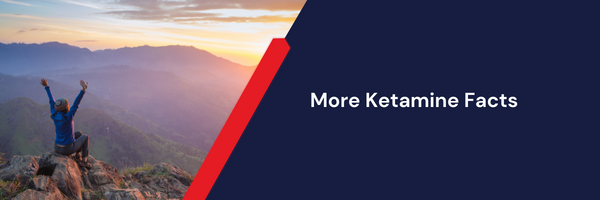
-
Ketamine therapy is used to treat mood disorders associated with addictions, such as alcohol use disorder, cocaine use disorder, and opiate use disorder, in combination with other treatments as well. Although ketamine is described as a ‘horse tranquilizer’, which makes ketamine seem very powerful, its use in the medical and mental health arena is at much lower doses. The safety record of ketamine is impressive. Misuse and abuse of ketamine can occur, but dependence is rare, and there is no physiological withdrawal. Ketamine therapy is actively being evaluated for its efficacy in treating addictions, such as alcohol use disorder. Its use in the medical arena is very safe, monitored, and with very low risk. The World Health Organization, in 2015, again defined the benefit and safety of ketamine.
-
Ketamine has been used since 1970 as an FDA anesthetic agent and has been on the World Health Organization’s Essential Medication List since 1985. It has been FDA approved since 2019 as Spravato for Major depression. Ketamine infusions are more effective than Spravato, based on several studies.
-
Ketamine is used in low, sub-anesthetic doses for mood disorders. You will be awake during the infusion and monitored closely by staff that have extensive medical and mental health experience. Treatments occur in a safe, relaxed, warm environment.
Contact Us Today
|
We look forward to hearing from you!Thanks,Christopher Sendi, M.D.571-999-2118 |
Ketamine, a fabricated chemical from the 1960’s, was FDA approved for anesthesia in 1970 and is listed as one of the safest drugs on the planet per the World Health Organization. The question of whether to use ketamine to treat your depression should not be a question of who should get the treatment but rather ‘why isn’t everyone getting ketamine treatment?’ As psylocibins are branded as ‘magic mushrooms’ and evoke mystical qualities, ketamine has unfairly been branded as a party drug or ‘horse tranquilizer.’ Yet, ketamine has been effectively proven to treat depression, mood disorders, and pain in numerous studies and is available to the public right now. Even with concerns over abuse and addiction, ketamine does not cause any traditional withdrawal symptoms which one would get from stopping cannabis or coffee. In fact, there is plenty of evidence that demonstrates the efficacy of ketamine in the treatment of addictions such as alcohol and opiate abuse.
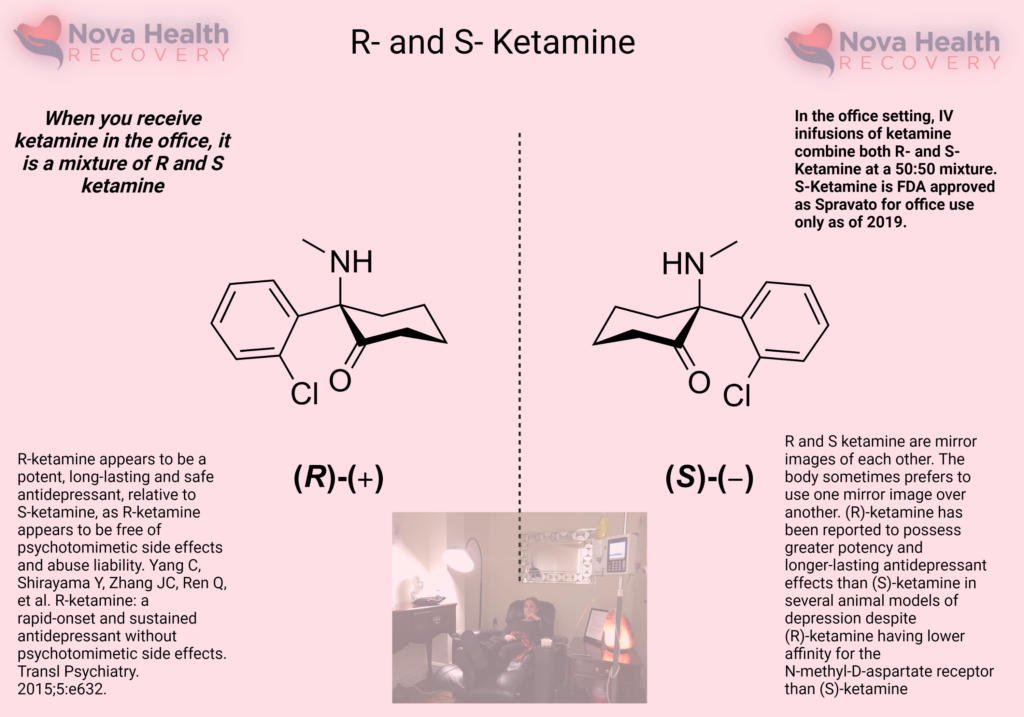
In 1956, a chemist (Victor Maddox) at pharmaceutical company Parke Davis in Detroit, Michigan was experimenting with synthesizing new compounds in an attempt to find a better anesthetic. A compound called phencyclidine was initially created, and in early animal studies it demonstrated unusual effects. Some animals exhibited a drunk-like state when administered with it, while others entered states of delirium.
Human tests quickly ruled out the compound as clinically useful with some patients exhibiting major delirious and dissociative states for prolonged periods of time. This was despite the fact the it did seem to function remarkably well as an anesthetic. In later years, phencyclidine hit the streets as a recreational drug, becoming infamous due it its violent side effects. Its street name was PCP, or angel dust.
In the early 1960s, Parke Davis researchers began searching for a phencyclidine derivative that could limit the compounds unmanageable side effects. It was here that ketamine was born through the work of Calvin Stevens and after successful animal tests, it was administered to the first human subject in 1964, demonstrating remarkable anesthetic effects.
Initially approved for veterinary uses, ketamine quickly found a place as an effective short-acting anesthetic and was approved by the FDA in 1970. One of its first major human uses was as a battlefield anesthetic in Vietnam. It has been suggested that this initial use in the early 1970s was what led to it moving into recreational circles as veterans returned to the United States and continued using the drug.
Non-medical uses continued throughout the 1970s, culminating in several high profile publications “outing” the drug. Perhaps the most infamous of these accounts came with scientist and psychonaut John C. Lilly’s 1978 autobiography The Scientist: A Novel Autobiography.
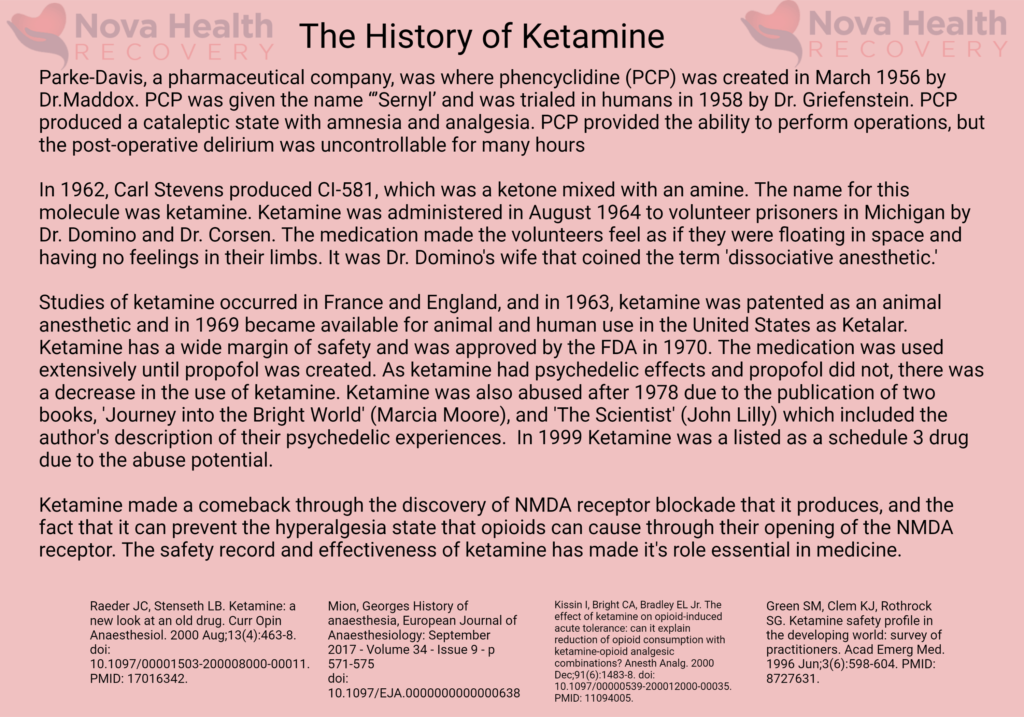
Ketamine works in numerous complex ways. It affects the glutamate system, which is the primary system of our brain involved with learning. Our entire cerebral cortex runs off glutamate as an excitatory neurotransmitter. It is balanced by GABA, which ‘calms’ the brain down. Serotonin, the molecule of happiness, and dopamine, the molecule of reward, are more primitive transmitters and, in fact, serotonin is present in locusts and causes them to swarm. These more ancient neurotransmitters are, in part, controlled by the functioning of the glutamate system, especially through the amygdala (the anxiety center) with the lateral habenula, both of which stop the release of serotonin and dopamine when there is excess glutamate. The glutamate system is the primary neurotransmitter in the cerebral cortex of mammals, and it effectively runs the ‘ecosystem’ of our brain, controlling most other operations. Excess glutamate can result in neuronal damage and death, loss of circuitry in the brain, and depression. Ketamine allows a brief glutamate burst and then shuts off the signal. This results in the formation of proteins and Brain Derived Neurotrophic Factor (BDNF) which in turn causes the production of dendrites and synapses (synaptogenesis) in neurons in key areas. This allows for the formation of new connections and new learning, which is a vital to its antidepressant effects. This is called neuroplasticity.
In effect, ketamine helps repair over-pruned neural circuits in the brain through the production of BDNF, new synapses, increased and strengthened neural connections, decreasing glutamate levels, shutting off the lateral habenula and amygdala to decrease anxiety, increasing serotonin and dopamine, and improving reward deficiency such that individuals feel more motivated and energetic. In fact, ketamine treats anhedonia, a situation in which the treatment of depression with typical medications results in no mood at all – no happiness or sense of fulfillment or excitement.
Glutamate and Neuroplasticity
Most of the cerebral cortex is run by Glutamate, a molecule of learning, and this is balanced by the neurotransmitter GABA. Glutamate bursts in the brain are excitatory and result in the production of new synapses or connections between neurons. The other name for this is neuroplasticity, and it is a key part of learning. We are always pruning our neural networks, creating new connections (dendrites and synapses) and increasing the number of neurons. This is part of the learning process, and this goes away in severe depression. This is why we frequently become vegetative when severely depressed, lying in bed all day, with our brain not really thinking of anything (paucity of thought). This is because the brain has shut down new learning due to lack of neuroplasticity. We move less, we think less, we sleep less (or more) and we feel anxious. We begin to ruminate over the same problems, which is the anxious side of our brain.
The Problem with Traditional Therapy
Traditional treatment for depression would include medications that frequently do not work in 1/3 of cases and may take months to begin to help. In addition, there are numerous side-effects of antidepressant medications, such as weight gain, impotence, and anhedonia. Anhedonia is effectively the state of having no mood, where there is no anticipatory reward nor is the person depressed. So, for some, they may become ‘undepressed’ after treatment, but they still cannot have a normal life because of anhedonia. They cannot return to work because of lack of motivation, energy, drive, and continued cognitive deficits as ‘brain fog.’ This is where some may lean on substances to help themselves feel better. The other issue with traditional medications is that they may take months to work. In the age of interventional psychiatry, this is too slow. Depression leads to poor functioning, brain fog, and irritability which impacts jobs, family, and personal goals.
Given the economic and personal damage that depression causes, why would anyone want to wait months to feel better? Ketamine offers a rapid response in days in over 70% of patients. In fact, mental health should be treated like an emergency, just like an infection or heart attack, with aggressive and rapid acting therapies because untreated mental health disorders increase medical risks, produce early death, and increase the risk of addictions. As a result, there is a decrease in quality of life, productivity, and personal fulfillment.
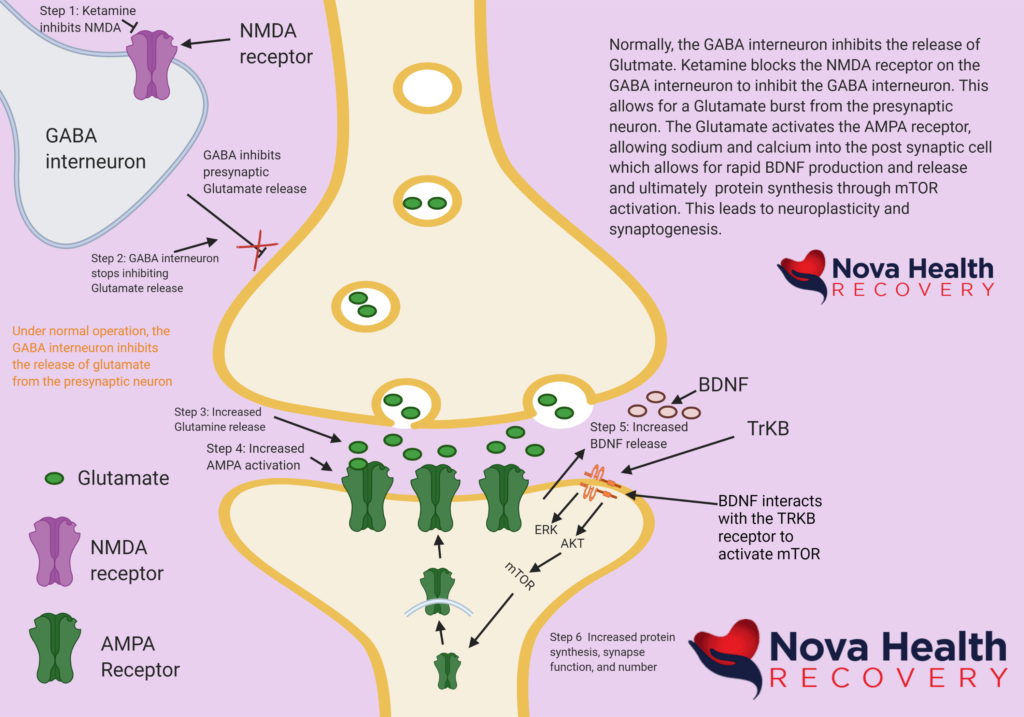
Depression Causes Cognitive Decline and Neurodegeneration – Brain Fog and Lower IQ
The Effect of Depression on your Cognition
What many do not recognize is the impact that poorly treated depression has on cognition. There is a decrease in the functioning of neural circuits in the brain such that areas (the Prefrontal Cortex) involved in decision-making, executive functioning, and impulse control become damaged and literally shrink. Also affected is the hippocampus, which is involved with working memory. This results in brain fog, poor insight, and poor decision-making and is visible on MRIs of the brain demonstrating decreased brain volumes in patients with mood disorders such as depression. Areas of the brain that sense reward also are altered, and this affects happiness and motivation. The basic things in life, such as a good movie, a delightful book, or an evening out on the town are not enjoyable or rewarding. There is a reward deficiency. Think about even smaller rewards such as brushing your teeth, combing your hair, getting out of bed, or taking a shower. Anyone who has been depressed may have found it impossible to get out of bed, brush their teeth, or even take a shower. That is because there must be a reward value associated with these activities. For example, by brushing your teeth, you will keep your teeth healthy so you can eat a steak in 10 years. This requires the ability of insight and delayed discounting, which is the ability to see value in things that may become rewarding later, even if it is a small reward. For example, there is nothing rewarding about taking ocular vitamins as you do not see better the next day after you take them. This is where the prefrontal cortex tells us that we should take vitamins to save our eyesight or even exercise when the activity is less than pleasurable. When we get depressed, our ability to see the value in any task becomes exceedingly difficult. We lose the ability for delayed discounting and the motivation to do even basic things in life.
The anti-reward areas of the brain, in particular, the amygdala and lateral habenula, control our responses to anti-rewards, or things that can cause us harm. These systems of the brain turn off the deeper neurotransmitter systems such as dopamine, or reward pathways, and serotonin, or happiness neurotransmitters. In depression and anxiety, this side of the brain is frequently running non-stop and leads to the anxiety one frequently experiences in depression.
Depression and Stress Result in Loss of Brain Connections (Synapses)
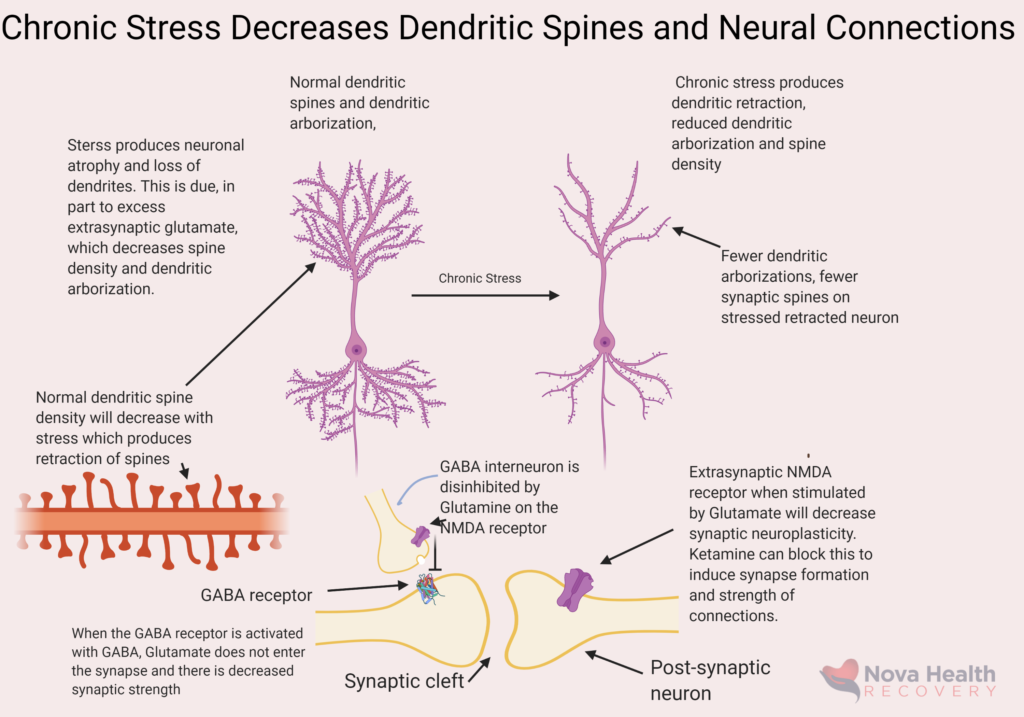
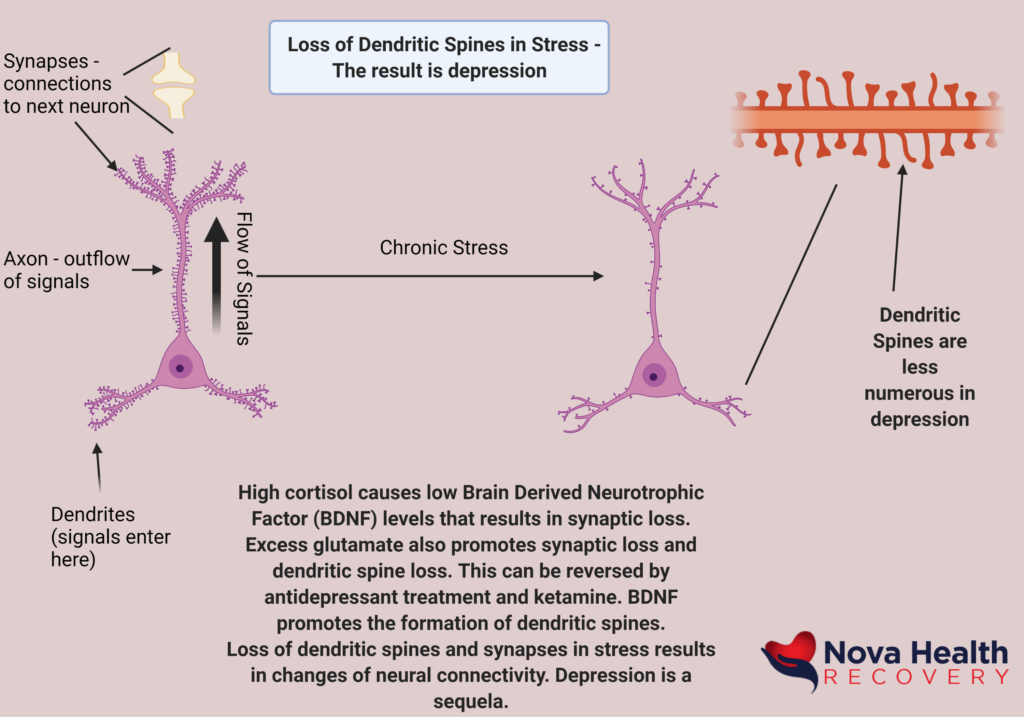
Mood Disorders Are Neurodegenerative – They Shrink Key Areas of The Brain Due to Neuron Loss
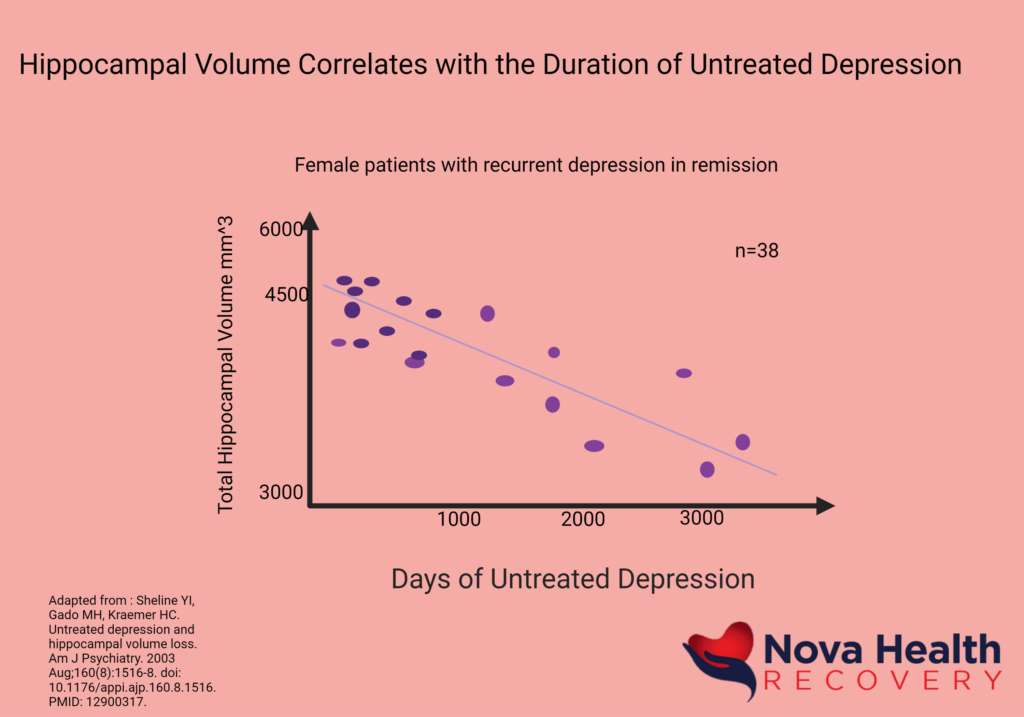
Loss Of Brain Volume and Loss Of Neuronal Connection Results in Loss of Cognition – Brain Fog
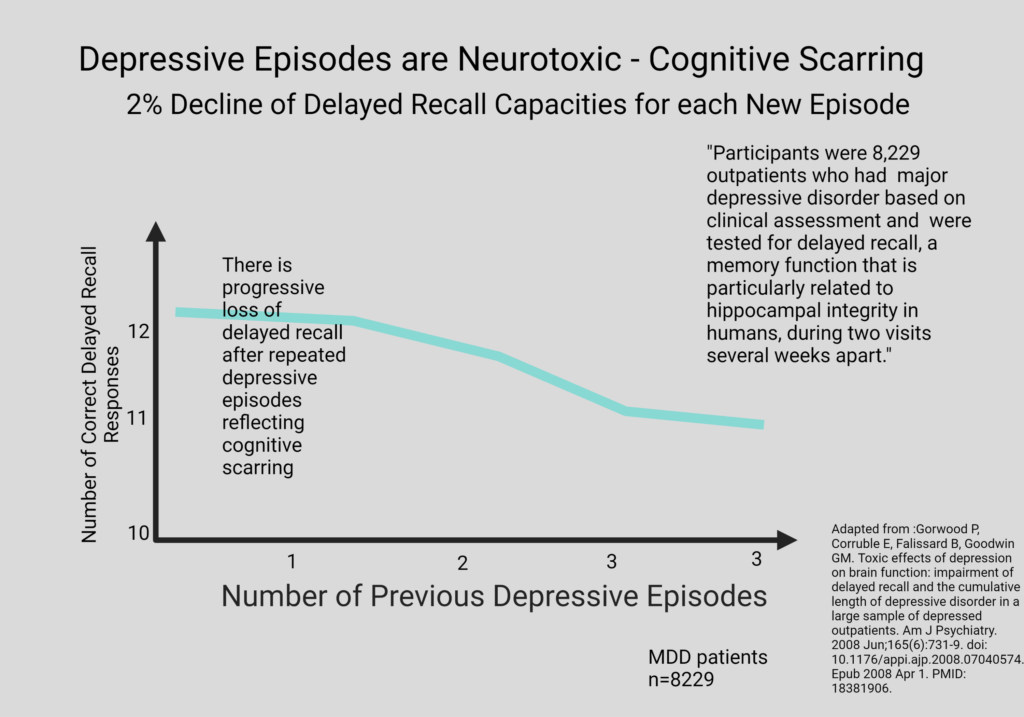
Brain Fog Results From Loss of Neural Circuit Connections, Neurons, and Synapses
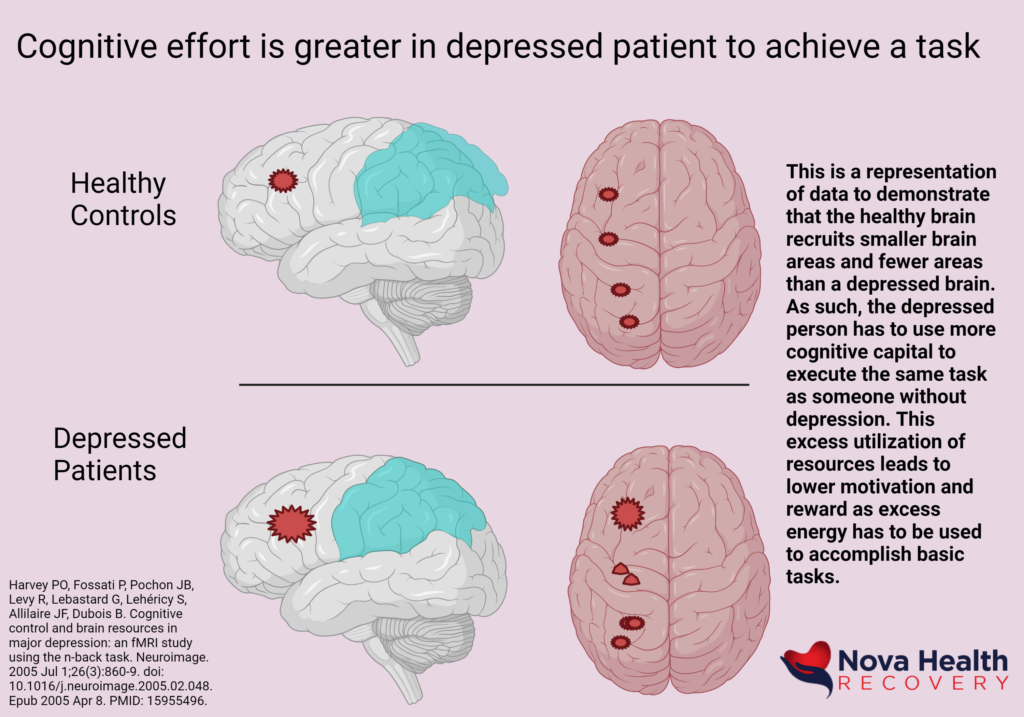
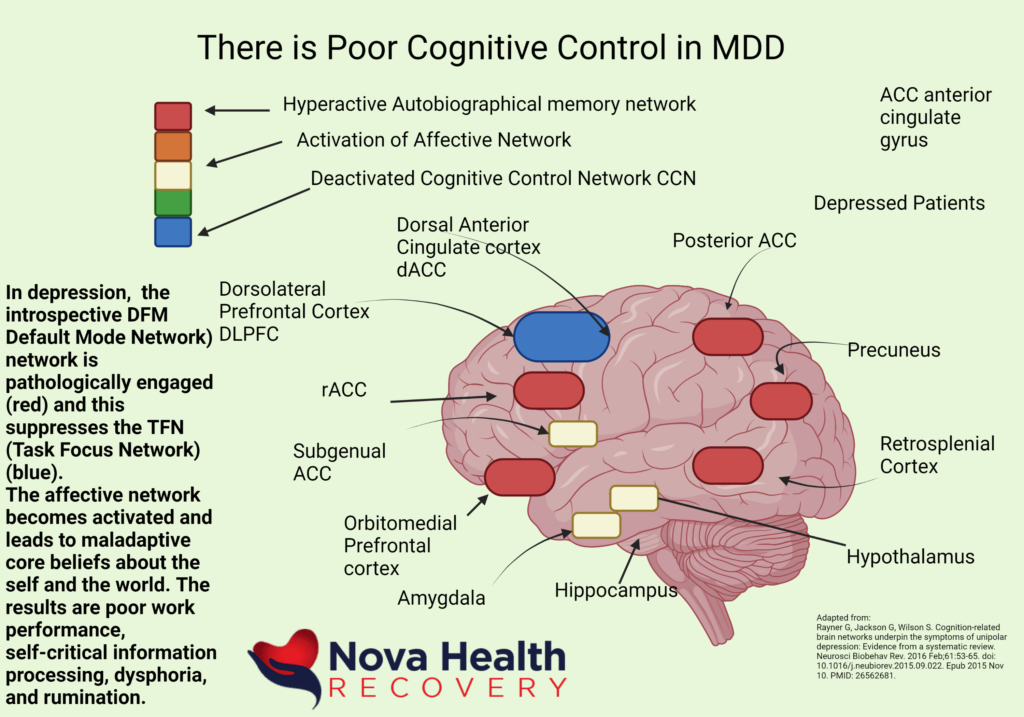
Brain Metabolism Decreases With Depression – This Causes Cognitive Decline and Low Motivation
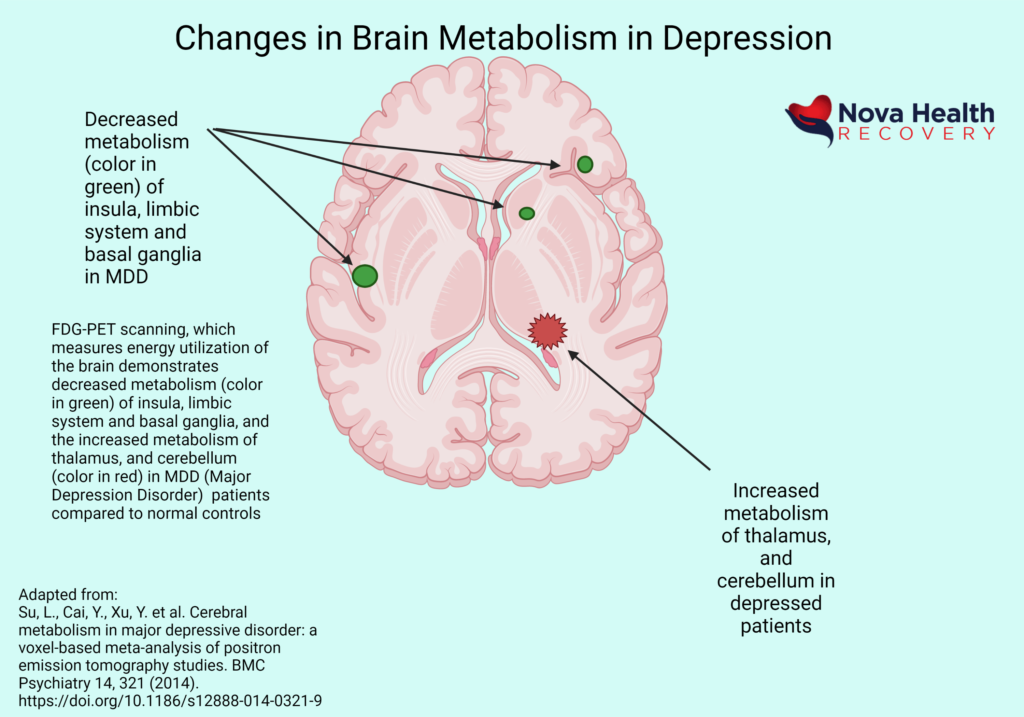
The Brain of A Depressed Patient Ages More Rapidly Due to Changes in Sirtuins

Glutamate is the primary Neurotransmitter in the Human Cortex – The Molecule of Learning
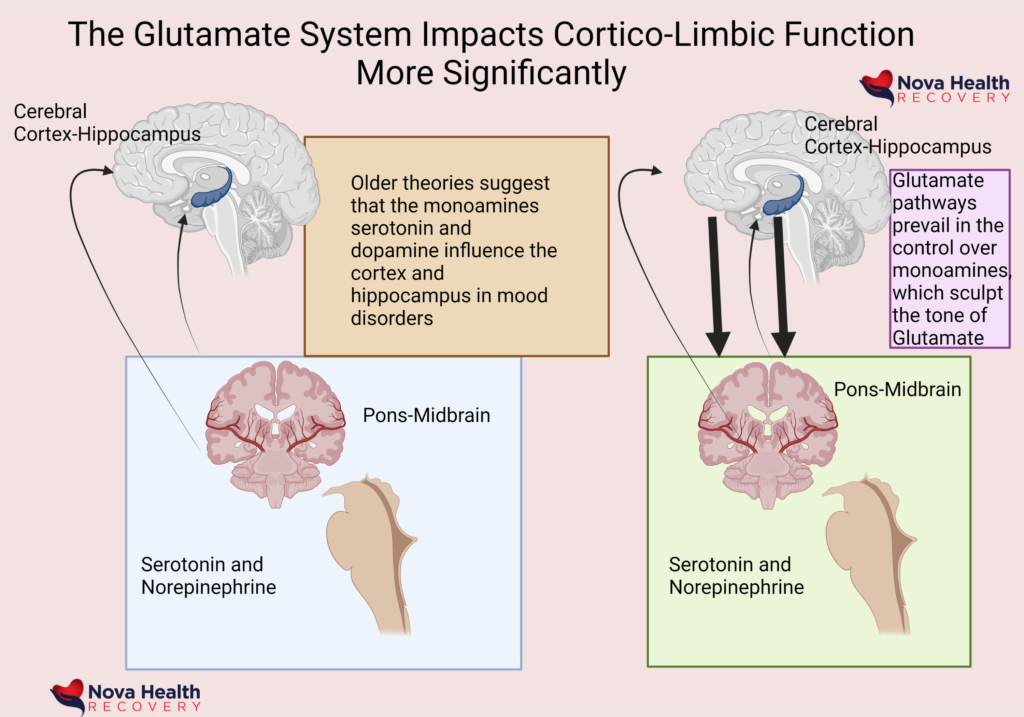
Glutamate and Neuroplasticity
Most of the cerebral cortex is run by Glutamate, a molecule of learning, and this is balanced by the neurotransmitter GABA. Glutamate bursts in the brain are excitatory and result in the production of new synapses or connections between neurons. The other name for this is neuroplasticity, and it is a key part of learning. We are always pruning our neural networks, creating new connections (dendrites and synapses) and increasing the number of neurons. This is part of the learning process, and this goes away in severe depression. This is why we frequently become vegetative when severely depressed, lying in bed all day, with our brain not really thinking of anything (paucity of thought). This is because the brain has shut down new learning due to lack of neuroplasticity. We move less, we think less, we sleep less (or more) and we feel anxious. We begin to ruminate over the same problems, which is the anxious side of our brain.
.
Increasing Brain Derived Neurotrophic Factor Is Key to Brain Health and Antidepressant Effects of Ketamine
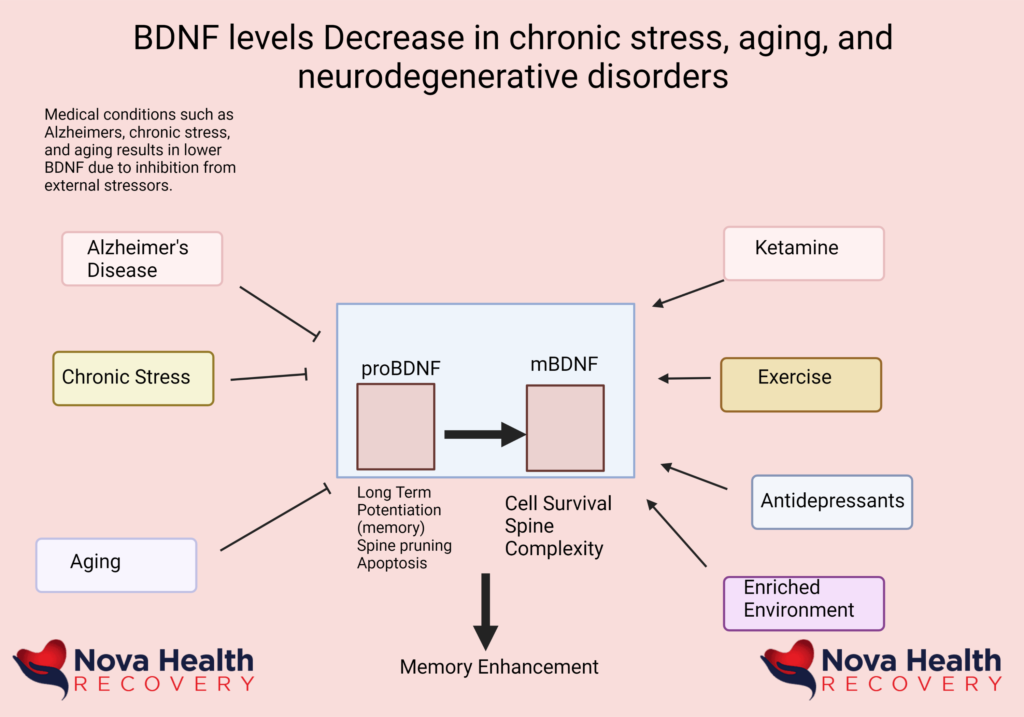
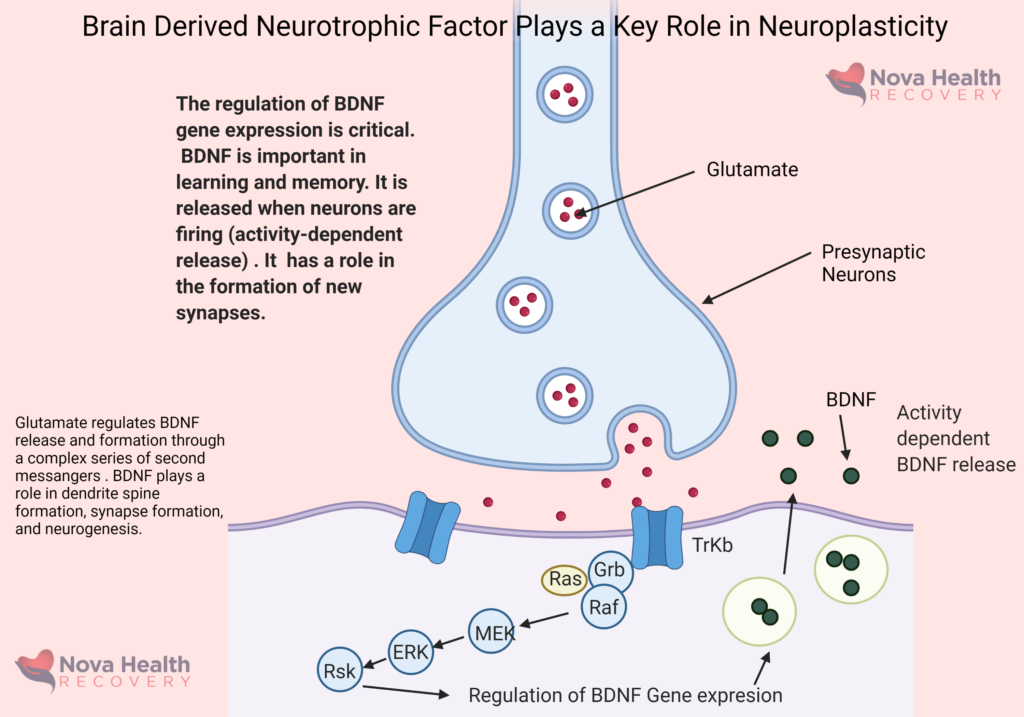
Ketamine Therapy Allows For Rapid Glutamate Signaling To Produce BDNF for Neuroplasticity
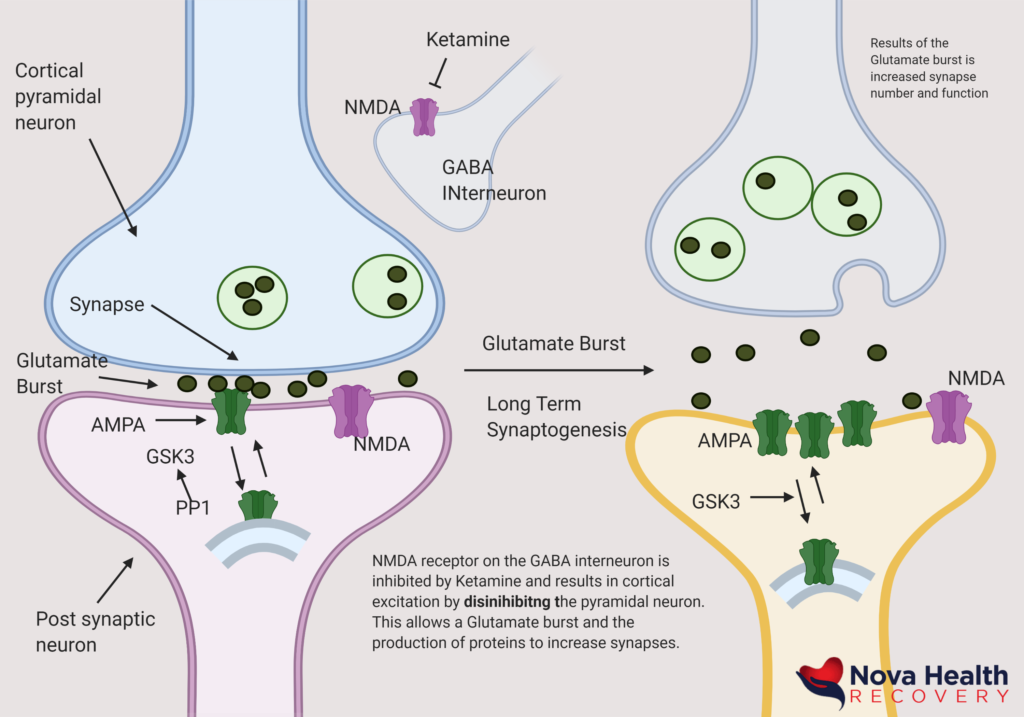
Traditional Antidepressants Fail to Work in 2/3 of Patients and May Take Months to Show Any Effect
The Problem with Traditional Therapy
Traditional treatment for depression would include medications that frequently do not work in 1/3 of cases and may take months to begin to help. In addition, there are numerous side-effects of antidepressant medications, such as weight gain, impotence, and anhedonia. Anhedonia is effectively the state of having no mood, where there is no anticipatory reward nor is the person depressed. So, for some, they may become ‘undepressed’ after treatment, but they still cannot have a normal life because of anhedonia. They cannot return to work because of lack of motivation, energy, drive, and continued cognitive deficits as ‘brain fog.’ This is where some may lean on substances to help themselves feel better. The other issue with traditional medications is that they may take months to work. In the age of interventional psychiatry, this is too slow. Depression leads to poor functioning, brain fog, and irritability which impacts jobs, family, and personal goals.
Given the economic and personal damage that depression causes, why would anyone want to wait months to feel better? Ketamine offers a rapid response in days in over 70% of patients. In fact, mental health should be treated like an emergency, just like an infection or heart attack, with aggressive and rapid acting therapies because untreated mental health disorders increase medical risks, produce early death, and increase the risk of addictions. As a result, there is a decrease in quality of life, productivity, and personal fulfillment.
The STAR*D Trial Demonstrated The Poor Performance of Traditional Antidepressants.
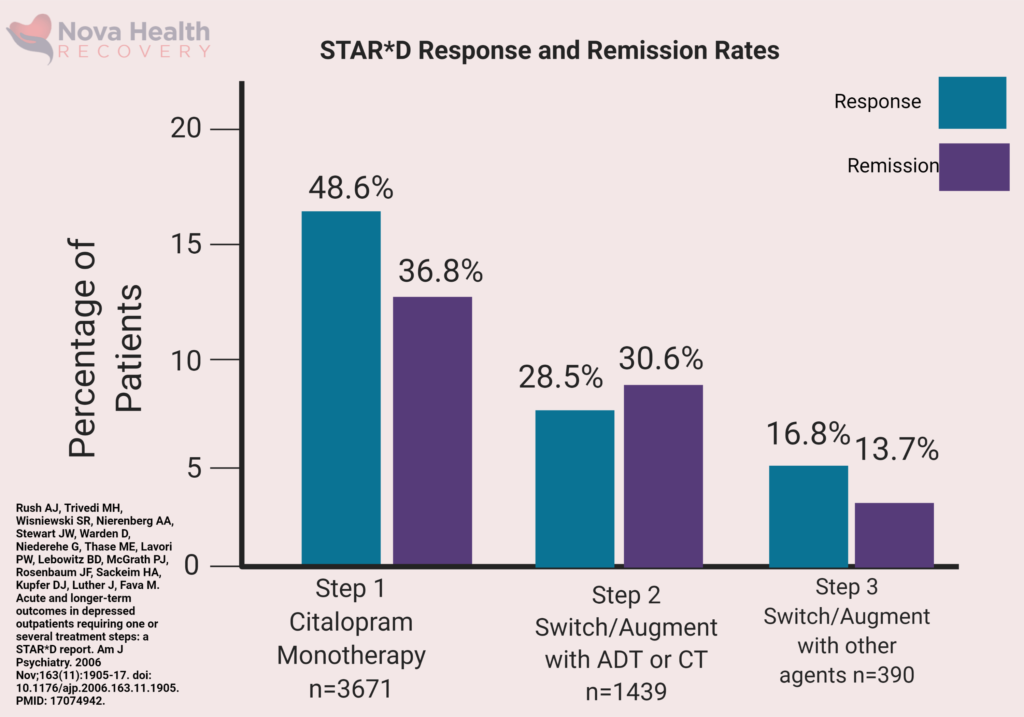
Depression and Mood Disorders Increase The Risk Of Heart Attack, Strokes, and Hypertension
Changes in Insulin and Weight Are Associated With Depression and Low Motivation
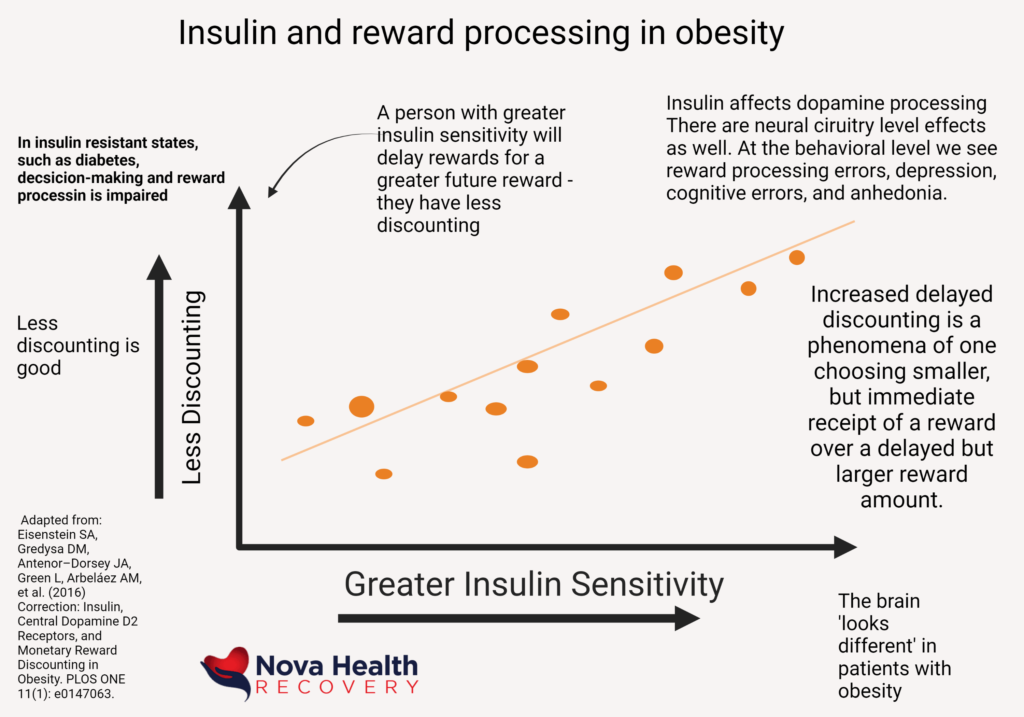
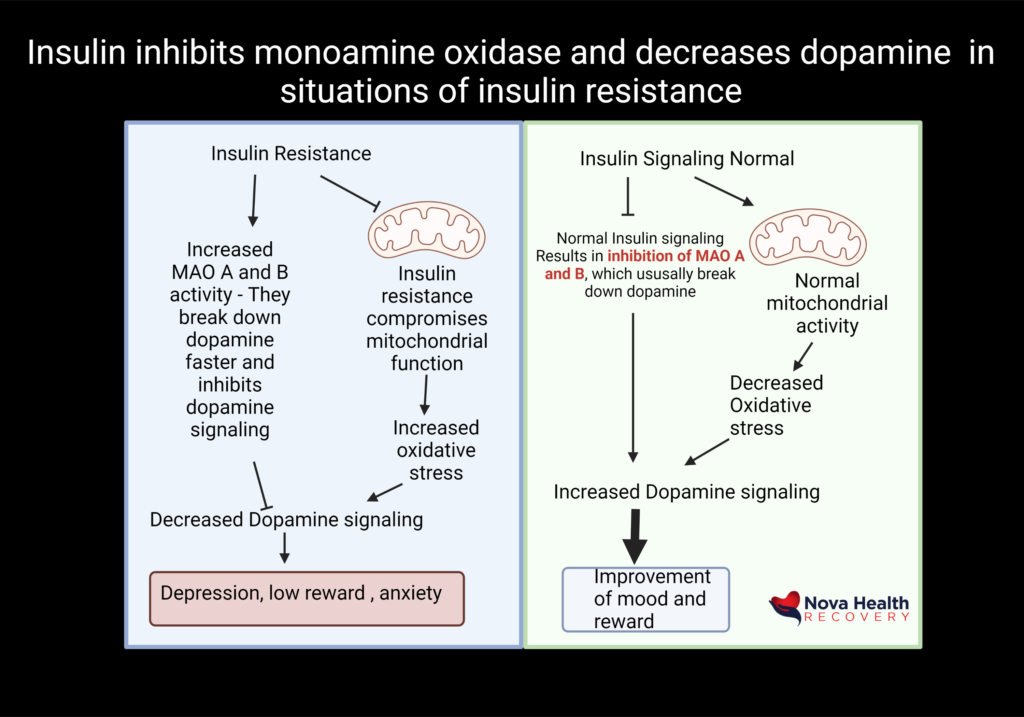
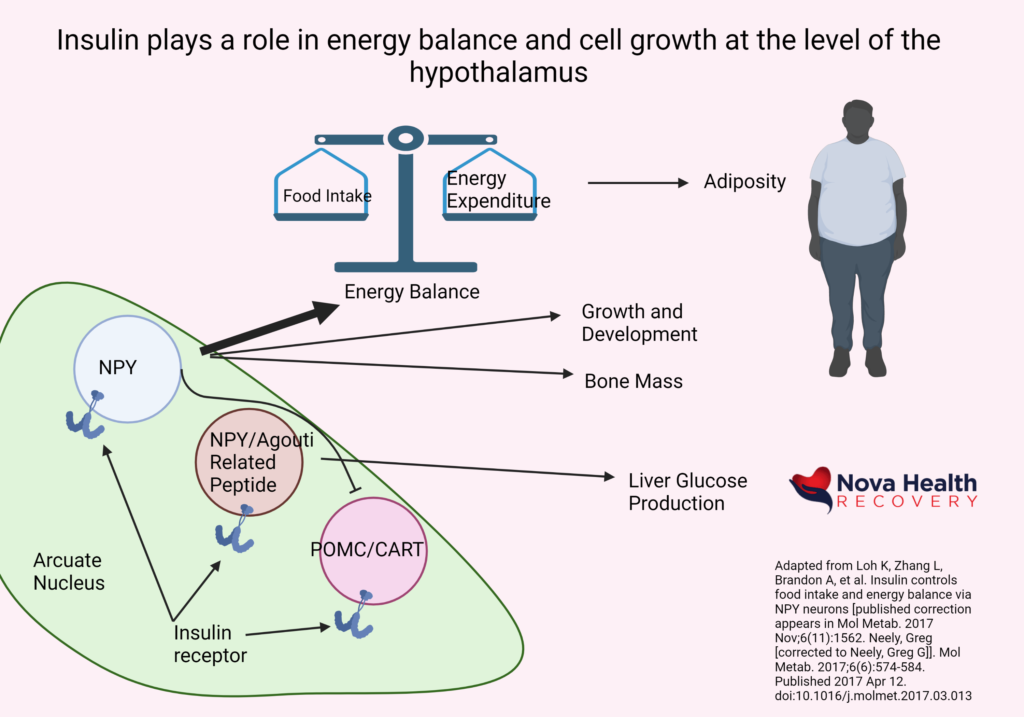
Ketamine Therapy Should Be Considered Early For Depression Treatment And Prevent Further Neurological Decline
Why Ketamine Therapy Should Be Your First Choice
Ketamine offers rapid treatment with a prominent level of success of 70% in treatment resistant patients. Given the metabolic complications that mental health disorders produce as well as loss of work, family disruptions, and personal struggles, it would be appropriate to consider ketamine therapy as a first-line treatment. It is better to prevent damage than react to it. Ketamine can be used alongside traditional medicines or as a stand-alone therapy. NOVA Health Recovery Ketamine Center in Alexandria, Virginia offers evaluation of your mental health disorder, consideration for treatment options, including Ketamine, Nitrous Oxide, scopolamine, Low level laser light therapy, NAD+ infusions, and compounded therapies. We do use home-based oral ketamine and home-based ketamine nasal spray therapies for maintenance of depression treatment. Remember, ketamine is a treatment, not a cure, so just like your hair, you must comb it and wash it frequently – the same goes with mental health. You need to maintain the lifestyle of better mental health just like a weight loss program.
Ketamine is Part of a Lifestyle Change
Ketamine should be one of the layers of treatment in every mental health condition. We can refer you for continued therapy with psychologists who are familiar with trauma, addiction, and severe mood disorders. Cognitive Behavioral Therapy has a significant role. We can adjust your medications as needed and help treat side-effects from them. Proper nutrition, medical weight loss, intermittent fasting, supplements, guided exercise, high intensity interval training, saunas, Yoga, Tai Chi, Craniosacral therapies, and many other therapies need to be incorporated into your recovery. Structured time and Boredom need to be addressed as they are root causes of depression and addiction. For some, a life coach would be valuable. Evaluations for secondary causes of depression, addiction, and mental health can also be addressed and these include small bowel overgrowth assessments, organic acid testing, Lyme disease and babesiosis testing, allergy testing, mycotoxins, and organic pollutant testing, as well as genetic testing for drug metabolism and supplement choice. Laboratory testing for vitamin D, thyroid, vitamin levels, autoimmune panels, heavy metals, copper, acute intermittent porphyria, pyrroles, sex hormones, and other labs can be assessed as well. Ketamine represents a huge step forward in the treatment of mental health disorders such as depression. Patients do not need a referral or psychiatrist, but patients with heart disease, kidney failure, liver failure, stroke, heart attacks, or schizophrenia would need a medical clearance for the procedure and treatment. The question of whether to get ketamine or not is simple: why wouldn’t a person want to get rapid results with a safe and available therapy when they have suffered so much? How has your mental health journey been so far? In minds that have fixed beliefs and cognitive rigidity where they cannot think creatively, the mantra of ‘that didn’t work the first time…let me try that again….and again….” tends to be an ongoing process. Not making a decision is actually making a decision to not consider therapies that may change your life. Everyone needs a push. Hopefully that choice is made early. You have to challenge yourself to change yourself.
Ketamine Therapy Improves Wellness Parameters That Traditional Medications Do Not: Such as Happiness, Hope, Motivation, Reward, Fatigue, and Energy.
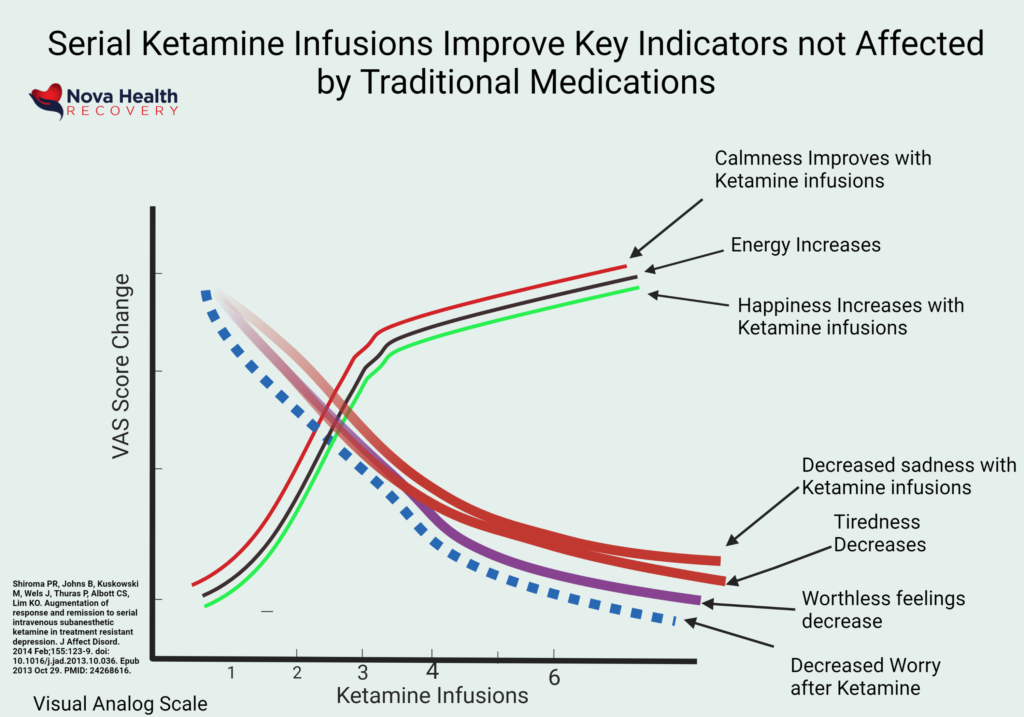
Sequential Ketamine Infusions Results in Remission or Response in over 70% of Treatment Resistant Patients
